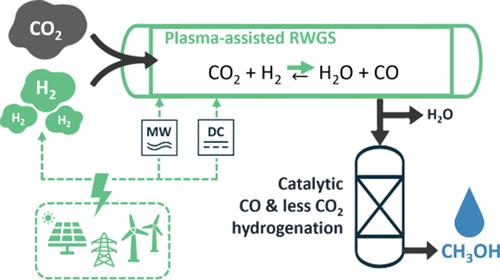当前位置:
X-MOL 学术
›
Ind. Eng. Chem. Res.
›
论文详情
Our official English website, www.x-mol.net, welcomes your feedback! (Note: you will need to create a separate account there.)
On the Electrification of CO2-Based Methanol Synthesis via a Reverse Water–Gas Shift: A Comparative Techno-Economic Assessment of Thermo-Catalytic and Plasma-Assisted Routes
Industrial & Engineering Chemistry Research ( IF 3.8 ) Pub Date : 2024-06-26 , DOI: 10.1021/acs.iecr.4c00301 Stavros-Alexandros Theofanidis 1 , Konstantinos Stergiou 2 , Evangelos Delikonstantis 1 , Georgios D. Stefanidis 2
Industrial & Engineering Chemistry Research ( IF 3.8 ) Pub Date : 2024-06-26 , DOI: 10.1021/acs.iecr.4c00301 Stavros-Alexandros Theofanidis 1 , Konstantinos Stergiou 2 , Evangelos Delikonstantis 1 , Georgios D. Stefanidis 2
Affiliation

|
A thorough cost analysis based on the conceptual process design of a two-step CO2-to-methanol synthesis route is performed, comprising CO2 hydrogenation in an electrified reverse water–gas shift (RWGS) reactor, followed by a conventional methanol synthesis reactor. In the former step, both thermal and nonthermal plasma reactors are considered, i.e., direct current (DC) arc and microwave (MW) plasma, respectively, and benchmarked against the conventional thermo-catalytic counterpart. It is found that employment of any type of plasma promotes higher CO2 conversions in the RWGS step than the conventional thermo-catalytic reactors (82–90 vs 61%), thereby higher single-pass methanol yields (24–27 vs 17%). This comes at the expense of higher electricity demand, which minorly affects the process economics since green H2 utilized in RWGS and methanol synthesis is the cost driver. The economic analysis shows that the current green H2 prices (2022 scenario) render the two-step CO2-to-methanol process economically unviable, regardless of the reactor technology used, attaining approximately a 4-fold higher levelized cost of methanol (LCOM), 1875–1900 €·ton–1, compared to the state-of-the-art route, i.e., syngas production through steam methane reforming (SMR) and coal gasification, followed by WGS and methanol synthesis reactors. However, the two-step CO2-to-methanol route could be viable for a long term (2050 scenario), driven by lower costs of electricity (10 €·MW h–1) and green H2 (1.0 €·kg–1) along with the avoided emission credits. This originates from the lower greenhouse gas (GHG) emissions that the two-step CO2-to-methanol route attains compared with the state-of-the-art. In the 2050 frame, plasma technologies are anticipated to be at least 45% more profitable than thermo-catalytic reactors, while the profitability of nonthermal plasmas will significantly improve if vacuum operation is avoided, mitigating the excessive compression energy demand and subsequently decreasing the operating cost.
中文翻译:

通过反向水煤气变换实现二氧化碳基甲醇合成的电气化:热催化和等离子体辅助路线的比较技术经济评估
基于两步 CO 2 合成甲醇路线的概念工艺设计进行了彻底的成本分析,其中包括电气化反向水煤气变换中的 CO 2 加氢(RWGS)反应器,然后是传统的甲醇合成反应器。在前一步中,分别考虑了热等离子体反应器和非热等离子体反应器,即直流(DC)电弧和微波(MW)等离子体,并以传统的热催化反应器为基准。研究发现,与传统的热催化反应器相比,使用任何类型的等离子体都可以在 RWGS 步骤中促进更高的 CO 2 转化率(82-90 vs 61%),从而提高单程甲醇产率(24 –27 vs 17%)。这是以更高的电力需求为代价的,这对工艺经济性影响较小,因为 RWGS 和甲醇合成中使用的绿色 H 2 是成本驱动因素。经济分析表明,当前的绿色 H 2 价格(2022 年情景)使得两步 CO 2 转化为甲醇的工艺在经济上不可行,无论使用何种反应器技术,与最先进的路线(即通过蒸汽甲烷重整生产合成气(SMR )和煤气化,然后是 WGS 和甲醇合成反应器。然而,在电力成本较低(10 €·MW h –1 ) 和绿色 H 2 (1.0 €·kg –1 ) 以及避免的排放信用。 这是因为与最先进的技术相比,两步式 CO 2 转化为甲醇的路线所实现的温室气体 (GHG) 排放量较低。到 2050 年,等离子体技术的利润预计将比热催化反应器高出至少 45%,而如果避免真空操作,非热等离子体的利润将显着提高,从而减轻过度的压缩能源需求,从而降低运营成本。
更新日期:2024-06-26
中文翻译:

通过反向水煤气变换实现二氧化碳基甲醇合成的电气化:热催化和等离子体辅助路线的比较技术经济评估
基于两步 CO 2 合成甲醇路线的概念工艺设计进行了彻底的成本分析,其中包括电气化反向水煤气变换中的 CO 2 加氢(RWGS)反应器,然后是传统的甲醇合成反应器。在前一步中,分别考虑了热等离子体反应器和非热等离子体反应器,即直流(DC)电弧和微波(MW)等离子体,并以传统的热催化反应器为基准。研究发现,与传统的热催化反应器相比,使用任何类型的等离子体都可以在 RWGS 步骤中促进更高的 CO 2 转化率(82-90 vs 61%),从而提高单程甲醇产率(24 –27 vs 17%)。这是以更高的电力需求为代价的,这对工艺经济性影响较小,因为 RWGS 和甲醇合成中使用的绿色 H 2 是成本驱动因素。经济分析表明,当前的绿色 H 2 价格(2022 年情景)使得两步 CO 2 转化为甲醇的工艺在经济上不可行,无论使用何种反应器技术,与最先进的路线(即通过蒸汽甲烷重整生产合成气(SMR )和煤气化,然后是 WGS 和甲醇合成反应器。然而,在电力成本较低(10 €·MW h –1 ) 和绿色 H 2 (1.0 €·kg –1 ) 以及避免的排放信用。 这是因为与最先进的技术相比,两步式 CO 2 转化为甲醇的路线所实现的温室气体 (GHG) 排放量较低。到 2050 年,等离子体技术的利润预计将比热催化反应器高出至少 45%,而如果避免真空操作,非热等离子体的利润将显着提高,从而减轻过度的压缩能源需求,从而降低运营成本。
















































 京公网安备 11010802027423号
京公网安备 11010802027423号